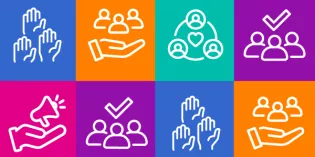These audit findings provide an insight into how emergency care settings were delivering services and care for children and young people prior to the COVID-19 pandemic.
Introduction
Facing the Future: Standards for Children in Emergency Care Settings, published in 2018, highlighted concerns around increasing expectations and demands for care, workforce pressures, mental health presentations and children with long term conditions and complex needs. The standards were intended to support those designing, organising and delivering emergency care services for children and young people as they endeavoured to address these challenges.
RCPCH are pleased to present this audit report, summarising the key findings from the analysis of 91 audit responses received from services across the UK from publication in 2018 until early 2020. These findings provide an insight into how emergency care settings were delivering services and care for children and young people prior to the COVID-19 pandemic.
The findings support the concerns highlighted in 2018 and confirm that they remain important issues for paediatric urgent and emergency care, alongside the additional pressures that have arisen in light of the COVID-19 pandemic response. Interruptions to the expected patterns of delivery of primary, community and acute services since March 2020 have impacted on all emergency care settings, and the consequences for children and young people have included a concerning increase in mental health presentations and significant overall increased pressures on emergency care services.
Just as the whole health system has adjusted to the demands of delivering care in a COVID-19 environment, now attention is turning to the important question of how to organise the recovery and restoration of services. The Facing the Future standards represent what is needed to ensure the delivery of high quality urgent and emergency care for our children and young people, and they should be at the centre of ongoing discussions across the system about service recovery, development and improvement. The findings of this work are intended to support those designing and delivering emergency care services for children and young people across the UK.
Dr Scott Hendry, Chair of Intercollegiate Committee for Standards for Children and Young People in Emergency Care Settings.
Acknowledgements
We are very grateful to all those who shared their self-assessments with us, allowing RCPCH to present the situation of emergency care standards for children and young people in the period before the COVID-19 pandemic.
Background
When RCPCH published Facing the Future: standards for children in emergency care settings in 2018 an audit toolkit was developed that allowed each emergency department (ED) to assess their own performance against the new standards. We invited services to share their results with the College so that aggregated and anonymised data could be published in support of better health services for children and young people.
Providing children and young people with the right urgent and emergency care at the right time, in the right place, requires a trained and competent workforce delivering care in an appropriate environment, supported by local policies and procedures, within a system that is integrated and designed for seamless care.
How this is achieved in practice is determined by a range of local, regional and national factors. We received audit results from a wide range of department types across the UK: paediatric EDs in stand-alone children’s hospitals, paediatric EDs in hospitals with paediatric inpatient facilities, and mixed emergency departments with and without paediatric inpatient units.
These results provide an insight into how emergency care settings were delivering for children and young people prior to the pandemic and indicates areas for improvement. The breadth of the standards reflects the many factors that together contribute to high quality services.
Data
This report presents the headline findings from an analysis of 91 responses that were received from service providers across the UK from publication in 2018 until early 2020. These are indicative results; they should not be interpreted as a definitive assessment of the standard of emergency care available to children and young people. The data annex discusses the limitations of these sources in more detail.
Our key findings
The 70 standards in Facing the Future: standards for children in emergency care settings are arranged across 12 themes. The summary analysis reveals wide variation in how many providers met these service standards.
Chart 1 shows how far service providers met standards in each theme. These results suggest that that pre-pandemic, the greatest opportunity for improvement was to be found in
- services for children and young people with mental health problems
- the emergency care environment, and
- integrated urgent and emergency care systems.
Results showed that on average, less than half of service providers reporting meeting the standards in these themes.
Chart 1 – Proportion of service providers reporting standards ‘met by theme

Chart 2 shows the proportion of service providers who reported that they were meeting each of the 70 standards. Nine individual standards were reported ‘met’ by at least 90 percent of service providers we heard from. These were:
- Standard 20 - Every emergency department treating children has an established Early Warning System.
- Standard 21 - Policies in place for the escalation of care for critically unwell children.
- Standard 22 - The appropriate range of drugs and equipment is available for facilities receiving unwell or injured children
- Standard 29 - All emergency care settings have guidelines for safeguarding children.
- Standard 30 - All staff in emergency care settings have access to safeguarding advice 24 hours a day from a paediatrician with safeguarding expertise
- Standard 32 - Systems are in place to identify children and young people who attend frequently.
- Standard 57 - Each region has a Paediatric Critical Care (PCC) Transport team, provided, managed and governed by its Paediatric Critical Care ODN.
- Standard 58 - The regional PICU has a dedicated, 24-hour transfer helpline, for critically ill or injured children, providing clinical support and advice, and co-ordinating paediatric retrievals and transfers.
- Standard 62 - All emergency departments caring for children have local agreed policies in place for responding to the unexpected death of a child.
Across the remaining 61 standards, there was scope to improve emergency care services for children and young people. The five standards that were reported least met were:
- Standard 4 – Emergency care settings are designed and provided to accommodate the needs of children and their parents/carers.
- Standard 11 – A minimum of two children’s nurses per shift in dedicated children’s emergency departments must possess recognisable post-registration trauma and emergency training.
- Standard 17 – All children attending emergency care settings are visually assessed by a doctor or nurse immediately upon arrival with clinical assessment undertaken within 15 minutes to determine priority category, supplemented by a pain score and a full record of vital signs.
- Standard 24 – Registered practitioners treating children in the emergency department deliver health promotion and accident prevention advice that is recorded in discharge summary notes
- Standard 47 - When CYP require access to a mental health in-patient bed but there is a delay >4 hrs, they are looked after in a suitable paediatric facility with appropriate in-patient facilities, regular CAMHS review, trained registered mental health nurses and paediatric nursing support.
The data annex shows the results for all standards by English regions, and for the nations and the UK.
Chart 2 – Proportion of service providers reporting standard ‘met'

Recommendations
We are aware there are some limitations to generalising these results to the current state of emergency care for children and young people; our data are historical (pre-pandemic) and not all centres returned data. Nevertheless, these data provide a unique and important insight into provision of emergency care for children and young people, and where further attention and improvement activity may be focused now. In that context, RCPCH makes the following recommendations:
- We urge all those involved in the planning and delivery of emergency care for children and young people to work towards meeting these standards. The granularity of the 70 standards in Facing the Future: Standards for Children in Emergency Care Settings allows individual departments and services to identify room for improvement locally, as well as setting expectations for regional and national policy development.
- We recommend all emergency departments providing care to children and young people in the UK reflect on how they are currently performing against the standards and draw on these summary results in focusing their quality improvement activities.
- We recommend that regional and national system leaders consider these findings in their work to support the recovery of the urgent and emergency care system following the pandemic. In particular, we highlight three themes that indicate considerable room to improve:
- The opportunity to develop integrated urgent and emergency care pathways across systems, to increase the opportunity to deliver the right care, to the right patients, in the right place at the right time.
- Taking all opportunities to improve the standards of emergency care for children and young people presenting in mental health crises
- Providing an emergency care environment that is tailored for and meets the specific needs of children and young people.
Next steps
With this report we want to start conversations locally, regionally and nationally around improvements in the delivery of emergency care for children and young people. These results show where attention can be usefully focused. We are aware from information service providers shared with us that quality improvements to meet the standards - across services, policy and practice - were underway at the time of reporting and this is encouraging.
As the system seeks to restore and recover from the effects of the COVID-19 pandemic, we hope all those involved in emergency care – at local, regional and national levels – can benefit from this analysis as they consider how to deliver better quality services.
RCPCH and the Intercollegiate Committee for Standards for Children and Young People in Emergency Care Settings will use these results to inform its future work in this area, its advocacy for better standards of care, and, in time, a review of the standards themselves.
If you would like to discuss this further, please contact health.policy@rcpch.ac.uk.










